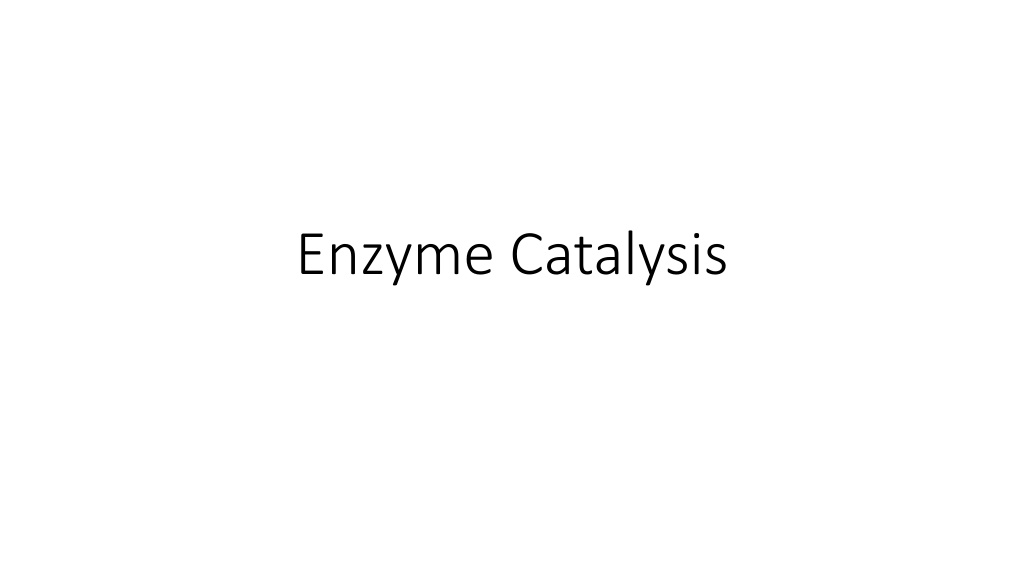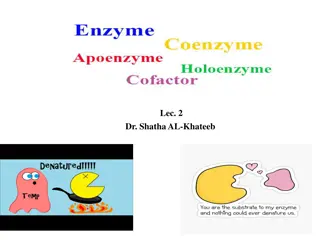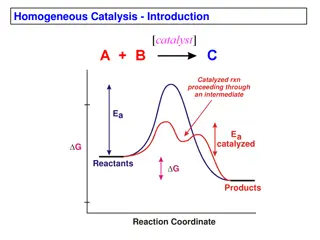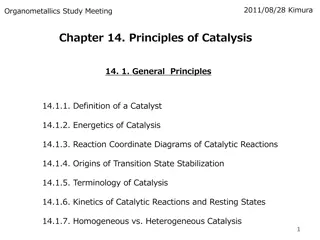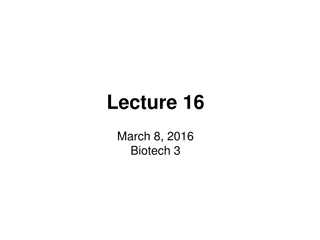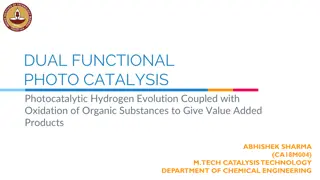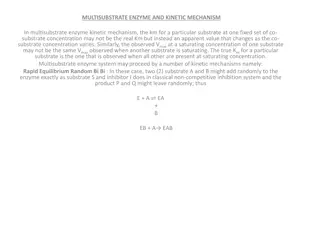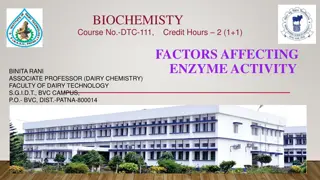Understanding Enzyme Catalysis and Active Site Role
Enzymes play a crucial role in catalyzing biochemical reactions by stabilizing transition states through their active sites. Different mechanisms like acid-base, covalent, metal, and electrostatic interactions are employed for stabilization. Acid-base catalysis involves acceleration without being consumed, while Brønsted-Lowry concept explains proton transfer. Aspartate Protease demonstrates acid/base catalysis using aspartic acid residues to manipulate water for nucleophilic attacks on substrate molecules.
Download Presentation

Please find below an Image/Link to download the presentation.
The content on the website is provided AS IS for your information and personal use only. It may not be sold, licensed, or shared on other websites without obtaining consent from the author. Download presentation by click this link. If you encounter any issues during the download, it is possible that the publisher has removed the file from their server.
E N D
Presentation Transcript
Role of Active Site It is called the magic Pocket It stabilizes the transition state It expels water It has got reactive groups Coenzyme interact at active site
Enzymes, employ different ways to stabilize transition states: 1. Acid-Base 2. Covalent 3. Metal 4. Electrostatic
Acid-Base Catalysis Acid base catalysis, acceleration of a chemical reaction by the addition of an acid or a base, the acid or base itself not being consumed in the reaction. The catalytic reaction may be acid-specific (acid catalysis). Example: Decomposition of the sugar sucrose into glucose and fructose in sulfuric acid. The catalytic reaction may be base-specific (base catalysis) Example: The addition of hydrogen cyanide to aldehydes and ketones in the presence of sodium hydroxide.
The BrnstedLowry concept of acids and bases as one in which there is an initial transfer of protons from an acidic catalyst to the reactant or from the reactant to a basic catalyst. In terms of the Lewis theory of acids and bases, the reaction entails sharing of an electron pair donated by a base catalyst or accepted by an acid catalyst.
Aspartate Protease- Acid/Base Catalysis They use two aspartic acid residues in their active site Water plays a very important role, these two hold that water in position As the substrate bound into the pocket of the enzyme and this has caused a conformational change that has changed the geometry of the water molecule with the two carboxyls The peptide chain the movement of this from water causes this carboxyl group to abstract this proton and create a reactive hydroxyl group so the proton is removed the oxygen that's left behind is negatively charged, it's a nucleophile and that oxygen attacks the peptide bond oxygen is not attached to anything, the nucleophilic attack causes the abstraction of the proton these are
Metalloenzymes- metal Catalysis Metalloproteinases are secreted as inactive zymogensA metal such as Cu2+or Zn2+can also stabilize the TS. The metal must be able to be bound to the charged intermediate and hence the TS. The tetrahedral oxyanion intermediate of the reaction of an electrophilic carbonyl C can interact with a metal if there is an O on an adjacent atom which can help coordinate the metal ion. This charge stabilization of the developing negative in the TS and the full negative in the intermediate is often called electrostatic catalysis. This method is likely to be found in many enzymes since nearly 1/3 of all enzymes require metal ions.
Biologically, Carboxypeptidase-A (CPA) facilitates the breakdown of proteins during metabolism, (commercial applications include its use the hydrolysis of cheese whey protein and the production of phenylalanine-free protein hydrolysates for use by individuals with phenylketonuria). CPA consists of a single Zn2+ion in its active site. Zn2+is stabilized within the active site through interactions with His, Glu, and His and is additionally bound by a catalytic water molecule that has that interact with Glu. Glu plays an important role, either acting as a general base-general acid or as a nucleophile.
Covalent Catalysis The activation energy of the reaction can also be lowered by introduction of new steps. A typical way is to add a nucleophilic catalyst which forms a covalent intermediate with the reactant. The original nucleophile can then interact with the intermediate in a nucleophilic substitution reaction. If the nucleophilic catalyst is a better nucleophile than the original nucleophile (usually water) then the reaction is catalyzed. The nucleophilic catalyst and the original nucleophile usually interact with a carbonyl C in a substitution reaction, initially forming the tetrahedral oxyanion intermediate. E.g. Cysteine Protease they have SH group, when the substrate come in the active site, the substrate induces the pulling of hydroxyl from the SH making the S a nucleophile. This nucleophile attacks the peptide bond of the protein and bring about its cleavage.
Superoxide Dismutase - Electrostatic Superoxide dismutase (SOD) represents a group of enzymes that use metal cofactor (nickel, iron, manganese, or copper/zinc ions). Superoxide dismutase detoxify superoxyde by catalyzing its dismutation. One superoxide molecule is being oxidized to O2 and another is reduced to H2O2. In the first step of reaction the ion metal is reduced by superoxide which loses its electron and is converted to molecular oxygen. As result, metal cofactor changes oxidation state (Ni3+ Ni2+, Fe3+ Fe2+, Mn3+ Mn2+and Cu2+ Cu1+). In second step of reaction the ion metal is oxidized by superoxide which accept electron from tetal and is converted to hydrogen peroxyde (Ni2+ Ni3+, Fe2+ Fe3+, Mn2+ Mn3+and Cu1+ Cu2+). As result, the enzyme is returned to its initial reactive state.
